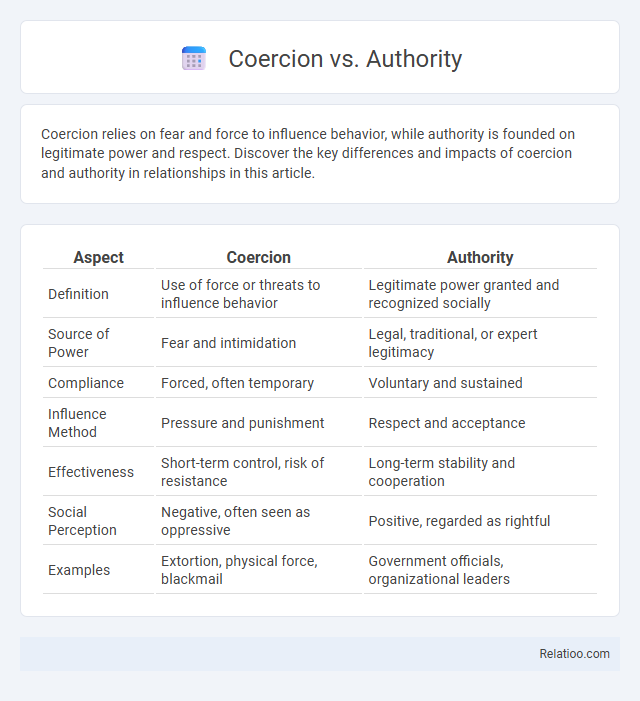Coercion relies on fear and force to influence behavior, while authority is founded on legitimate power and respect. Discover the key differences and impacts of coercion and authority in relationships in this article.
Table of Comparison
| Aspect | Coercion | Authority |
|---|---|---|
| Definition | Use of force or threats to influence behavior | Legitimate power granted and recognized socially |
| Source of Power | Fear and intimidation | Legal, traditional, or expert legitimacy |
| Compliance | Forced, often temporary | Voluntary and sustained |
| Influence Method | Pressure and punishment | Respect and acceptance |
| Effectiveness | Short-term control, risk of resistance | Long-term stability and cooperation |
| Social Perception | Negative, often seen as oppressive | Positive, regarded as rightful |
| Examples | Extortion, physical force, blackmail | Government officials, organizational leaders |
Understanding Coercion: Definition and Key Features
Coercion involves the use of force or threats to make someone comply, often disregarding their consent or free will. It contrasts with authority, which is legitimate power derived from accepted rules or social structures, ensuring voluntary obedience. Understanding coercion helps you recognize when power is exercised through intimidation rather than legitimate influence or respect.
Defining Authority: What Sets It Apart?
Authority is defined by its legitimate power recognized and accepted by others, distinguishing it from coercion, which relies on force or threats. Unlike coercion, authority commands voluntary obedience because it is backed by established rules, social norms, or institutional roles. Understanding this distinction helps you navigate power dynamics effectively, recognizing when influence is earned versus imposed.
Historical Perspectives on Coercion and Authority
Historical perspectives on coercion and authority reveal evolving power dynamics where coercion often involved force or intimidation to maintain control, while authority derived from recognized legitimacy and social contracts. Throughout history, regimes relying heavily on coercion faced resistance and instability, contrasting with authorities who secured lasting governance through legal-rational or traditional legitimacy. Understanding these distinctions helps you analyze how historical societies balanced power, consent, and order in shaping political structures.
Psychological Foundations of Coercion vs Authority
Psychological foundations of coercion rely on fear and threat perception, leading to compliance through anticipated punishment or negative consequences, often triggering stress and resistance responses. Authority, grounded in legitimacy and social norms, fosters voluntary acceptance and internalized obedience by aligning with an individual's belief systems and perceived legitimacy of the power holder. The distinction involves coercion activating extrinsic control mechanisms while authority operates through intrinsic motivation and social identification processes.
Social Impacts: Coercion Compared to Authority
Coercion relies on force or threats to influence behavior, often leading to fear, resistance, and social fragmentation, while authority derives from recognized legitimacy and voluntary compliance, promoting social cohesion and stability. The social impact of coercion is typically negative, fostering distrust and undermining social norms, whereas authority supports trust, cooperation, and collective order within communities. Sustained reliance on coercion can erode social capital, whereas authority enhances social integration and institutional legitimacy.
Coercion in Governance: Risks and Consequences
Coercion in governance involves using force or threats to compel compliance, often undermining trust and legitimacy in political institutions. Excessive reliance on coercion can lead to social unrest, human rights violations, and erosion of democratic principles. Balancing coercion with legitimate authority ensures sustainable governance and protects civil liberties.
Authority in Leadership: Building Voluntary Compliance
Authority in leadership hinges on the ability to inspire voluntary compliance by establishing trust, credibility, and clear expectations. Unlike coercion, which relies on fear and force, authority encourages followers to willingly align with goals through respect and shared values. Your leadership becomes more effective when authority fosters collaboration and intrinsic motivation, driving sustainable commitment.
Ethical Considerations: Coercion vs Legitimate Authority
Coercion involves forcing individuals to act through threats or manipulation, often undermining ethical principles such as autonomy and consent. Legitimate authority, grounded in established laws and moral justification, commands obedience by gaining voluntary compliance and respecting individual rights. Ethical evaluation distinguishes coercion by its violation of freedom, whereas legitimate authority is recognized for upholding justice and societal order.
Case Studies: Coercion and Authority in Practice
Case studies on coercion and authority reveal stark contrasts in organizational outcomes, with coercion often leading to resistance and reduced morale, while authority grounded in legitimacy fosters compliance and cooperation. When you analyze instances such as political regimes or corporate leadership, the effectiveness of authority depends on recognition of power as rightful rather than imposed through force. Data from research on leadership styles highlights that authority built on trust and expertise drives sustained success, unlike coercion which typically yields short-term control with long-term instability.
Striking a Balance: Fostering Authority Without Coercion
Striking a balance between coercion and authority is essential for effective leadership, ensuring your influence is rooted in respect rather than fear. True authority fosters trust and motivation by empowering individuals, whereas coercion relies on force and compliance that can undermine relationships. Cultivating this balance promotes a positive environment where collaboration and accountability thrive without sacrificing personal autonomy.

Infographic: Coercion vs Authority
 relatioo.com
relatioo.com